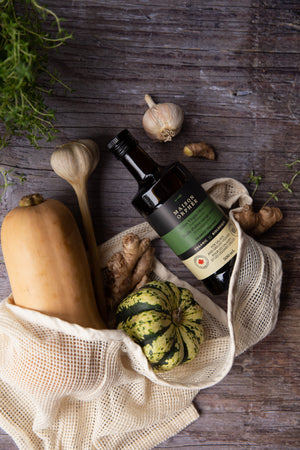FREQUENTLY ASKED QUESTIONS
Is it possible to purchase your products directly from your factory?
Unfortunately, it is not possible. Instead, we invite you to visit one of our 3,000 retail locations in Canada to find our products. You can use our store locator to facilitate your search.
Why don't you offer all your products on your online boutique anymore?
This difficult decision aims to ensure the viability of the company while continuing to provide you with quality products. The costs associated with an online boutique are significant, and even after attempting to minimize expenses, we have arrived at this conclusion.
The positive aspect of this transition is reflected in an enhancement of our services, including the implementation of an efficient store locator and the introduction of monthly discount coupons. For more information, check out Why we decided to close our online boutique
Are all your products organic?
No, not all. However, we have a nice selection of certified organic products. You will find the certification logo on the label of the relevant products.
Where do the ingredients used in the manufacturing of your products come from?
We source high-quality ingredients, prioritizing local producers from Quebec and Canada first, and then from international producers with whom we have established trusted relationships.
How and for how long can I store my products?
Most of our products can be stored at room temperature in a cool, dry place before opening, except for flaxseed oil and fresh mayonnaises. Products requiring refrigeration after initial use are clearly labeled as such on their packaging.
We recommend consuming the products before the expiration date mentioned on the packaging, except for flaxseed oil, which should be used within 4 weeks after opening.
Do Maison Orphée products contain gluten?
We do not consider our ingredients to be high-risk for gluten contamination, which is why we have chosen to perform internal control without subscribing to a certification.
Here is how we ensure the absence of gluten in our products:- We do not purchase any ingredients or manufacture any products that are a direct source of gluten in our facilities.
- Ingredients we purchase, recognized as being more at risk of gluten contamination (e.g., spices, tamari sauce, etc.), are certified Gluten-Free by a reputable firm, and this certification is verified.
- Each of our suppliers must annually complete an allergen declaration. We ensure, based on the responses provided, that there is no risk of cross-contamination with gluten in their facilities.
Our quality assurance program is very rigorous concerning various claims or certifications displayed on our products. We consistently ensure their accuracy, and if changes affecting the safety or health of our consumers occur, we make sure to modify the labeling before market release.
Are your bottles recyclable?
Yes, glass is a widely recyclable material when facilities allow for it.
Are your Bag-in-Box (BIB) packages recyclable?
Yes, except for the black pouring spout.
OILS
What is the method of extracting olive oil?
The method is cold extraction. This heat-free method allows for better control of manufacturing parameters, better preservation of natural properties, and improved shelf life since this process significantly reduces the risk of olive oil oxidation.
What does extra virgin mean?
This term applies exclusively to cold-pressed olive oil. It should not exhibit any taste defects according to laboratory analyses.
To learn more, check out this blog article : When Extra Virgin = Extra Marketing
What are the attributes of extra virgin olive oil?
It is mandatory to find peppery, bitter, and fruity notes for it to be called extra virgin olive oil.
To learn more, check out this blog article : When Extra Virgin = Extra Marketing
Why do oils not always have the same taste?
The taste of oils depends on the region, the variety of oilseeds used, and the harvest period (whether it was early or at full ripeness), much like wines. The oil never tastes the same from season to season, production to production, batch to batch, or field to field. That's what's interesting about our virgin oils: they retain all the properties that nature has given them, unlike refined oils.
What is the acidity level of your olive oils?
Our olive oils have an oleic acidity of 0.8%, meeting the standards set for extra virgin olive oil by the International Olive Council.
My olive oil has a bitter taste. What does that mean?
Bitterness is actually a positive term in the world of extra virgin olive oil. To be called extra virgin, the oil must have a pronounced presence of bitterness.
To learn more, check out this blog article : When Extra Virgin = Extra Marketing
I feel a peppery sensation at the back of my throat after swallowing your olive oil —what does that mean?
This is one of the best indicators of an olive oil rich in polyphenols. The polyphenols contribute to the peppery character of an oil and prevent oxidation. These polyphenols are powerful antioxidants with many beneficial effects. This unique sensation and the throat tickle or cough that may accompany it are indicators of high-quality olive oil.
To learn more, check out this blog article : When Extra Virgin = Extra Marketing
What is first cold pressing?
It is a process in which non-preheated oilseeds are pressed only once, without heat and at the lowest possible temperature, to extract a portion of the oil they contain. This type of pressing helps preserve the flavours and nutritional elements of the oil.
Is your canola oil certified non-GMO?
Yes.
Why is canola oil so yellow and strong-tasting?
Unlike commercial refined oils, our canola oil is cold-pressed. The seeds are simply pressed, and the oil is filtered and bottled. In commercially refined oils, the taste, colour, and some nutrients have been chemically removed.
Is your sunflower oil oleic?
Yes, it is oleic, so it is rich in monounsaturated fatty acids (omega-9). We carefully select sunflower seeds to achieve this result. Additionally, omega-9 fatty acids have anti-inflammatory properties.
What are the benefits of cold-pressed canola oil?
Cold-pressed virgin canola oil contains a high amount of natural antioxidants and an interesting profile of omegas 3, 6, and 9 fatty acids. It also has anti-inflammatory properties.
Which oils contain the most omega-3 fatty acids?
Flaxseed oil, canola oil, and walnut oil.
VINEGARS
Is it normal that I can't find the expiration date on your vinegars?
Yes. Due to their composition, vinegars are not products in which bacteria can form or reproduce. Vinegars are good until the last drop.
Are your vinegars filtered and pasteurized?
No.
MUSTARDS
Do the mustards contain gluten?
No. Naturally, none of the ingredients in our mustards contain gluten, and we ensure, through supplier allergen declarations, that they are not at risk of containing gluten.
Why didn't the lid of my mustard jar "pop" when I opened it?
Simply because our mustards are not hot-packed. The small black adhesive tab ensures that the product has not been opened.
MAYONNAISES
Why do your mayonnaises always need to be refrigerated?
Our mayonnaises are made with entirely natural ingredients, without artificial preservatives. Therefore, we cannot guarantee the product's preservation at room temperature and strongly recommend that it be kept refrigerated at all times.
Are there preservatives in your mayonnaises?
Unlike other mayonnaises on the market, which contain EDTA and sometimes other artificial preservatives, ours are made with natural ingredients.
SEA SALTS
Is there iodine in your salt?
Despite not adding iodine to sea salt, it naturally contains some. Our salt has an iodine content of less than 0.5 mg/kg.
Is your sea salt Celtic?
In a nutritional values table, the composition of grey salt and Celtic salt is very similar since both are sea salts. The main difference between the two is that our grey sea salt comes from the salt marshes of the island of Noirmoutier, while Celtic salt comes from the Celtic Sea.
To learn more, check out this blog Everything You Need to Know About Salt.

